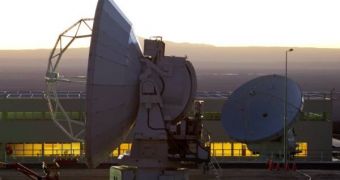Engineers dealing with the Atacama Large Millimeter/submillimeter Array (ALMA), currently under construction in the Chilean Andes and the result of an international cooperative effort, announced another milestone in the project, namely the construction and connection of two of the future telescope's antennas. The two dishes were connected together by a series of sophisticated computers, which allowed astronomers operating the center to look at Mars with the interferometry technique. Upon completion, ALMA will have 66 large, 12-meter and 7-meter in diameter antennas, which will all be connected via interferometry in a single, powerful array.
The advantage that this astronomical observation technique brings forth is the fact that it can make a number of antennas work together, and can resolve images as if they were taken with a telescope sporting an objective the size of the distance between the antennas that are part of the network. That is to say, if a telescope were to have antennas separated by 2,000 miles of land, then the picture obtained by using the two would have the resolution of one taken with an antenna 2,000 miles in diameter.
“This can only be achieved with the perfect synchronization of the antennas and the electronic equipment: a precision much better than one millionth of a millionth of a second between equipment located many kilometers apart. The extreme environment where the ALMA observatory is located, with its strong winds, high altitude, and wide range of temperatures, just adds to the complexity of the observatory and to the fascinating engineering challenges we face,” the ALMA Project Engineer, Richard Murowinski, said.
“We are on target to do the first interferometry tests at the 5000-metre high-altitude site by the end of this year, and by the end of 2011 we plan to have at least 16 antennas working together as a single giant telescope,” ALMA's Director, Thijs de Graauw, added. The project is scheduled to be completed sometime in the next decade, by 2015 tops, engineers share. When completed, the 62 antennas will offer astronomers more than 1,000 coupling possibilities, with distances between each receiver ranging from one to 16 kilometers.
ALMA brings together research communities from a number of countries in Europe, East Asia and North America, and enjoys the full cooperation of Chilean authorities. Upon completion, it will be one of the largest and most complex submillimeter telescopes in the world, and will provide background coverage for Earth-based optical interferometers, such as the ESO Very Large Telescope Interferometer (VLTI).

 14 DAY TRIAL //
14 DAY TRIAL //